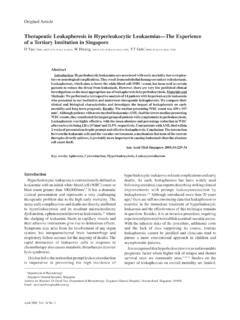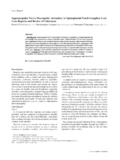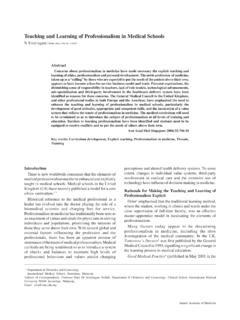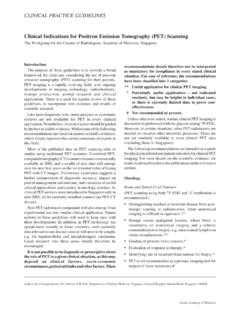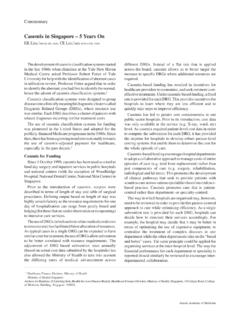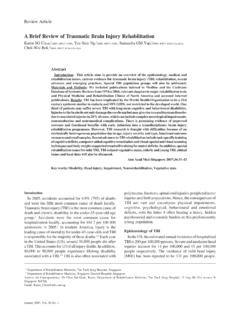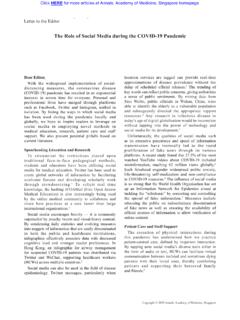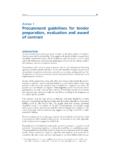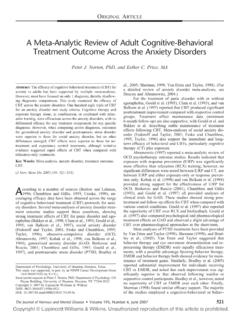Transcription of Comparison of Completely versus Incompletely …
1 68 Annals Academy of MedicineIncompletely excised SCCs P Ang et alComparison of Completely versus Incompletely excised CutaneousSquamous Cell CarcinomasP Ang,1 MBBS, MRCP (UK), AWH Tan,2 MBBS, MRCP (UK), CL Goh,3 FAMS, M Med, FRCP (Edin)IntroductionNon-melanoma skin cancer is the most common skincancer worldwide and its incidence has risen in the last Approximately 80% of non-melanoma skin cancersare basal cell carcinomas and the rest are squamous cellcarcinomas (SCCs). While the former grow slowly bycontiguous extension and are largely localised, SCCs have thepotential to metastasize to regional lymph nodes and distantorgans via the blood stream, and hence are associated with ahigher mortality rate.
2 SCCs can be treated with varioustechniques, including curettage and electrodessication,cryotherapy, radiotherapy, surgical excision and Mohsmicrographic We report our data on completelyversus Incompletely excised SCCs in our series of and MethodsAll patients with histologically confirmed SCCs which wereexcised in the National Skin Centre from 1991 to 1995 weretraced from computerised records and the data unconfirmed SCCs, SCCs treated with othermodalities and in situ SCC were excluded.
3 Information regardingthe patients sex, age, aetiological risk factors, tumour duration,tumour characteristics, surgical treatment and outcome wererecorded. All patients were also recalled for physical which were Completely excised and incompletelyexcised were placed into two subgroups and total of 57 patients and 63 SCCs were identified over this1 Consultant2 Registrar3 Medical Director and Senior ConsultantNational Skin Centre, SingaporeAddress for Reprints: Dr Ang Por, National Skin Centre, 1 Mandalay Road, Singapore.
4 This is a retrospective case series of cutaneous squamous cell carcinomas (SCCs)which were Incompletely excised in National Skin Centre, Singapore from 1991 to 1995. Thisstudy compared the characteristics of Completely excised versus Incompletely excised cutaneousSCCs. Materials and Methods: All patients with histologically confirmed SCCs were traced fromcomputerised medical database and information regarding patient profile, tumour characteris-tics, surgical treatment and outcome were collated.
5 All patients were recalled for clinicalexamination and documentation of cure. Completely excised and Incompletely excised SCCswere compared with regards to the patient and tumour characteristics. Results: There were 57patients with 63 SCCs who were treated with surgical excision over the 5-year period. Fifty wererecalled for physical examination. There were 30 males and 27 females and their mean age years. All except 1 were Chinese of Fitzpatrick skin type 4. One-third of patients had dailyor weekly sun exposure in the past and had occupational sun exposure; had priorarsenic exposure and were previously treated with radiotherapy for other mean duration of SCCs was months; of patients had multiple SCCs and underlying actinic keratoses.
6 The mean diameter of the tumours was cm and nearly halfwere located on the head and neck. All the SCCs were primary and localised to the skin; them were Completely excised with a 4 to 6 mm margin. Incompletely excised SCCs wereassociated with the male sex, larger tumours and tumours on the genitals and lower : In our experience, the tumour clearance rate is following conventionalexcision. Incomplete excision is associated with male sex, larger tumours and those on the genitalsand lower Acad Med Singapore 2004;33:68-70 Key words: Incomplete excision, Squamous cell carcinoma, Tumour clearanceOriginal ArticleJanuary 2004, Vol.
7 33 No. 169 Incompletely excised SCCs P Ang et alperiod. There were 30 males and 27 females, giving a ratio to 1. All were Chinese with Fitzpatrick skin type 4 exceptfor 1 Caucasian. Their ages ranged from 52 to 104 years, witha mean of years. One-third (19/57) of patients had dailyor weekly sun exposure in the past and (12/57) ofpatients had past or present occupational sun exposure. Two( ) patients had prior arsenic exposure and 2 ( ) werepreviously treated with radiotherapy for other were transplant recipients or immunosuppressed.
8 Only 1patient had psoriasis treated with ultraviolet A (UVA) SCCs were present for a mean duration of monthsbefore diagnosis (range; 3 weeks to 120 months). Almost half(30/63, ) of the SCCs were located on the head and neck, (16/63) on the lower limbs, 19% (12/63) on the upperlimbs, (3/63) on the genitals and (2/63) on thetrunk. The mean diameter of the SCCs was cm; (10/63) of tumours had underlying actinic keratoses. None hadmetastases to regional lymph nodes or distant all 63 SCCs which were excised with 4 or 6 mm marginsaccording to hospital guidelines, 10 ( ) were found to beincompletely excised on histology (Table 1).
9 These were from10 different patients. Surgical failure was defined as residualtumour at or within 1 mm to the lateral or deep margins of theexcised specimen. The mean age of the 10 patients was , and 70% were males (Table 1). Four tumours were onthe head and neck, 3 were on the lower limb, 2 were on thegenitals and 1on the upper limb. There was a higher proportionof tumours located in the genitals and lower limbs in thissubgroup. The mean tumour diameter was cm, which wasbigger than that of Completely excised tumours.
10 Sevenunderwent successful re-excision, one had re-excision followedby radiotherapy, one declined further surgery and was treatedwith radiotherapy alone, and 1defaulted on follow-up. The patients in the subgroup of Incompletely excised tumourswere mostly males (70%), and the tumours tended to be slightlylarger ( cm), with a higher proportion on the genitals(20%) and lower limbs (30%).Fifty patients ( ) were contacted or recalled for clinicalexamination. Eight of these patients had died from othercauses.
